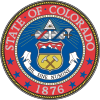Pikes Peak
| Pikes Peak | |
|---|---|
| Heey-otoyoo' (Arapaho) | |
 View of Pikes Peak | |
| Highest point | |
| Elevation | 14,115 feet (4,302 m) [1]NAVD88 |
| Prominence | 5,530 feet (1,690 m) [2] |
| Isolation | 60.6 mi (97.6 km) [2] |
| Listing |
|
| Coordinates | 38°50′26″N 105°02′39″W / 38.8405322°N 105.0442048°W / 38.8405322; -105.0442048Coordinates: 38°50′26″N 105°02′39″W / 38.8405322°N 105.0442048°W / 38.8405322; -105.0442048 [1] |
| Geography | |
 Pikes Peak Colorado | |
| Location | High point of El Paso County, Colorado, United States[2] |
| Parent range | Front Range, Highest summit of the Pikes Peak Massif[2] |
| Topo map | USGS 7.5' topographic map Pikes Peak, Colorado[3] |
| Geology | |
| Age of rock | ~ 1.05 Gyr |
| Mountain type | granite |
| Climbing | |
| First ascent | 1820 — Edwin James and party |
| Easiest route | Barr Trail Manitou and Pike's Peak Railway Pikes Peak Highway |
Pikes Peak is the highest summit of the southern Front Range of the Rocky Mountains, in North America. The ultra-prominent 14,115-foot (4,302.31 m) fourteener is located in Pike National Forest, 12 miles (19 km) west of downtown Colorado Springs, Colorado. The mountain is named in honor of American explorer Zebulon Pike, who was unable to reach the summit. The summit is higher than any point in the United States east of its longitude.[2][3]
Contents
1 Mountain
2 Geography and geology
3 Discovery
4 History
5 Today
6 Climate
7 Historical names
8 See also
9 References
10 Further reading
11 External links
Mountain
Pikes Peak is one of Colorado's 53 fourteeners, mountains more than 14,000 feet (4,267.2 m) above sea level. The massif rises 8,000 ft (2,400 m) above downtown Colorado Springs. Pikes Peak is a designated National Historic Landmark.
Tava or "sun", is the Ute word that was given by these first people to the mountain that we now call Pikes Peak. The band of Ute people who called the Pikes Peak region their home were the Tabeguache, meaning the "People of Sun Mountain".[4] The Ute people first arrived in Colorado about 500 A.D., although their traditions state they were created on Pikes Peak. In the 1800s, when the Arapaho people arrived in Colorado, they knew the mountain as Heey-otoyoo' meaning "Long Mountain".[5] Early Spanish explorers named the mountain "El Capitán" meaning "The Leader". American explorer Zebulon Pike named the mountain "Highest Peak" in 1806, and the mountain was later commonly known as "Pike's Highest Peak". American explorer Stephen Harriman Long named the mountain "James Peak" in honor of Edwin James who climbed to the summit in 1820. The mountain was later renamed "Pike's Peak" in honor of Pike. The name was simplified to "Pikes Peak" by the United States Board on Geographic Names in 1890.
Geography and geology
Pikes Peak is composed of a characteristic pink granite called Pikes Peak granite. The color is due to a large amount of potassium feldspar. It is thought that the granite was once magma that crystallized at least 20 miles (32 km) beneath the Earth's surface, formed by an igneous intrusion during the Precambrian, approximately 1.05 billion years ago, during the Grenville orogeny. Through the process of uplifting, the hardened rock pushed through the Earth's crust and created a dome-like mountain, covered with less resistant rock. Years of erosion and weathering removed the soil and rock leaving the exposed mountain.
Soils on Pikes Peak are classified as Cirque Land above timberline (approximately 12,000 feet or 3,657 m); forests at lower altitudes are mostly supported by brown stony sandy loam of the Catamount or Ivywild series.[6]
Discovery
The first Europeans to discover Pikes Peak were the Spanish in the 1700s. The first American sighting is often credited to members of the Pike expedition, led by Zebulon Pike. After a failed attempt to climb to the top in November 1806, Pike wrote in his journal:
- ...here we found the snow middle deep; no sign of beast or bird inhabiting this region. The thermometer which stood at 9° above 0 at the foot of the mountain, here fell to 4° below 0. The summit of the Grand Peak, which was entirely bare of vegetation and covered with snow, now appeared at the distance of 15 or 16 miles from us, and as high again as what we had ascended, and would have taken a whole day's march to have arrived at its base, when I believed no human being could have ascended to its pinical [sic]. This with the condition of my soldiers who had only light overalls on, and no stockings, and every way ill provided to endure the inclemency of the region; the bad prospect of killing any thing to subsist on, with the further detention of two or three days, which it must occasion, determined us to return.[7]
History
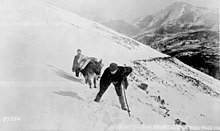
An 1890 winter climb (near Windy Point) up Pikes Peak

Manitou and Pike's Peak Railway train rounding Windy Point, around 1900.
The first European-American to climb the peak came 14 years after Pike, in the summer of 1820. Edwin James, a young student who had just graduated from Middlebury College in Vermont, signed on as the relief botanist for Stephen Harriman Long's expedition after the first botanist had died. The expedition explored the South Platte River up as far as present-day Denver, then turned south and passed close to what James called "Pike's highest peak". James and two other men left the expedition, camped on the plains, and climbed the peak in two days, encountering little difficulty. Along the way, James was the first to describe the blue columbine, Colorado's state flower.
Gold was discovered in the area of present-day Denver in 1858, and newspapers referred to the gold-mining area as "Pike's Peak". Pike's Peak or Bust became the slogan of the Colorado Gold Rush (see also Fifty-Niner). This was more due to Pikes Peak's visibility to gold seekers traveling west across the plains than any actual significant gold find anywhere near Pikes Peak. Major gold deposits were not discovered in the Pikes Peak area until the Cripple Creek Mining District was discovered southwest of Pikes Peak and led, in 1893, to one of the last major gold rushes in the lower 48 states.

The summit of Pikes Peak in 1901
In July 1860, Clark, Gruber and Company commenced minting gold coins in Denver bearing the phrase "Pike's Peak Gold" and an artist's rendering of the peak (sight unseen) on the obverse. In 1863, the U.S. Treasury purchased the minting equipment for $25,000 (or $510,000 adjusted for inflation) to open the Denver Mint.
Julia Archibald Holmes and James Holmes traveled to the Rocky Mountains in Colorado in 1858, and reached the summit on August 5, with J. D. Miller and George Peck, making Archibald Holmes the first European-American woman to climb Pikes Peak. From the summit, she wrote in a letter to her mother: "Nearly everyone tried to discourage me from attempting it, but I believed that I should succeed; and now here I am, and I feel that I would not have missed this glorious sight for anything at all."[8][9]
Thirty-five years later, in July 1893, Katharine Lee Bates wrote the song "America the Beautiful", after having admired the view from the top of Pikes Peak. It appeared in print in The Congregationalist, a weekly journal, on July 4, 1895. A plaque commemorating the words to the song was placed at the summit.
On July 17, 1913 William Wayne Brown drove his car, the Bear Cat, 20 miles (32 km) to the summit.[10][11] The ascent took 5 hours and 28 minutes.
The uppermost portion of Pikes Peak, above 14,000 feet (4,300 m) elevation, was declared a National Historic Landmark in 1961.[12][13]
Pikes Peak was the home of a ski resort from 1939 until 1984.[14]
Today
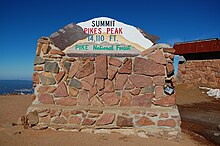
The sign at the summit

Pikes Peak dominates the backdrop of Garden of the Gods.
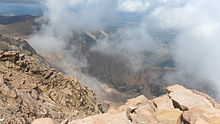
View from Pikes Peak summit looking north
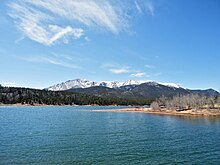
View of Pikes Peak from the Crystal Creek Reservoir
There are several visitor centers on Pikes Peak, some with a gift shop and restaurant. These centers are located at the 6-mile (9.7 km) and 12-mile (19 km) markers of the toll road, plus one at the summit itself.
Along with other food, the Summit House sells special high altitude doughnuts, frying up to 700 per hour.
The doughnuts collapse or go mushy if transported to lower altitudes.[15]
There are several ways to ascend the mountain. The Manitou and Pike's Peak Railway, the world's highest cog railroad,[16] operated from Manitou Springs to the summit, conditions permitting but closed in 2018. While the cog railroad is closed for refurbishing between 2017 and 2021, and a temporary shuttle system has taken part of its place, a number of outfitters have stepped in to provide transportation up the mountain, including Gray Line buses and Jeep and Hummer excursions from vendors such as Adventures Out West.[17]
Road vehicles can be driven to the summit via the Pikes Peak Highway, a 19 mi (31 km) road that starts a few miles up Ute Pass at Cascade. The road has a series of switchbacks, treacherous at high speed, called "The W's" for their shape on the northwest side of the mountain. The road is maintained by the city of Colorado Springs as a toll road. A project to pave the remainder of the road was completed on October 1, 2011.[18] The project is in response to a suit by the Sierra Club over damage caused by the gravel and sediment that is constantly washed off the road into the alpine environment.[19][20] The road remained open during construction.
The Highway is famous worldwide for the annual Pikes Peak International Hill Climb, a motor race. The short film Climb Dance features Ari Vatanen racing his Peugeot automobile up the steep, twisty slopes. It also hosts the Pikes Peak Cycling Hill Climb (formerly Assault on the Peak), a cycling hillclimb race first held in 2010,[21] and the USA Cycling Hill Climb National Championships, a race first held in 2016.[22]
The most popular hiking route to the top is called Barr Trail, which approaches the summit from the east. The trailhead is just past the cog railway depot in Manitou Springs. Visitors can walk, hike, or bike the trail. Although the Barr Trail is rated only Class 1 it is a long and arduous hike with nearly 8,000 ft (2,400 m) of elevation gain, and a 13 mi (21 km) trip one-way. Runners race to the top and back on Barr Trail in the annual Pikes Peak Marathon. Another route begins at Crags Campground, approaching the summit from the west.[23]
Since the end of 1922, the AdAmAn Club has been a unique group of mountaineers who climb the icy slopes of Barr Trail on the east face of Pikes Peak each year on December 30th, stay overnight at Barr Camp, and continue to the top on December 31. Then, at the stroke of midnight on New Year's Eve, the thirty or so AdAmAn members and their guests ignite a glorious fireworks display from the summit to usher in the New Year.[24]
Since 1969, the summit of Pikes Peak has been the site of the United States Army Pikes Peak Research Laboratory, a medical research laboratory for the assessment of the impact of high altitude on human physiological and medical parameters of military interest.
On June 4, 2018 ground-breaking was held for a new 38,000 square feet (3,500 m2) Summit Complex which will be constructed next to the current Summit House. The older facility will remain open to the more than 600,000 visitors annually through the end of construction in the fall of 2020. The new complex will include a visitor center, a communications facility for Colorado Springs Utilities, and the Army's High-Altitude Research Laboratory.[25][26]
Climate
At the peak, the partial pressure of oxygen is only about 60% of that at sea level. Water boils at 186 °F (86 °C) at 14,000 feet, rather than 212 °F (100 °C) at sea level.[27]
A faster rate of respiration is required by humans and animals not regularly at high altitudes.[28]Altitude sickness may develop in those who are sensitive or who over-exert themselves.
The summit of Pikes Peak has a polar climate due to its elevation. Snow is a possibility any time year-round, and thunderstorms are common in the summer.[29] Surrounding areas have different climatic variations depending on location and elevation. Much of the area near Pikes Peak has a continental semiarid climate, while other areas would be classified as hemiboreal.
| Climate data for Pikes Peak summit. (Elevation 14,115ft) | |||||||||||||
|---|---|---|---|---|---|---|---|---|---|---|---|---|---|
| Month | Jan | Feb | Mar | Apr | May | Jun | Jul | Aug | Sep | Oct | Nov | Dec | Year |
| Average high °F (°C) | 8.1 (−13.3) | 10.6 (−11.9) | 14.0 (−10.0) | 19.7 (−6.8) | 28.4 (−2.0) | 38.5 (3.6) | 47.6 (8.7) | 48.1 (8.9) | 39.2 (4.0) | 28.4 (−2.0) | 16.0 (−8.9) | 10.7 (−11.8) | 25.8 (−3.4) |
| Average low °F (°C) | −3.7 (−19.8) | −2.9 (−19.4) | −0.8 (−18.2) | 4.6 (−15.2) | 14.3 (−9.8) | 24.6 (−4.1) | 33.7 (0.9) | 32.9 (0.5) | 24.3 (−4.3) | 14.2 (−9.9) | 3.9 (−15.6) | −2.7 (−19.3) | 11.9 (−11.2) |
| Source: summitpost.org[30] | |||||||||||||
Historical names
- Tava
- El Capitán
- Grand Peak
- Heey-otoyoo'
- Highest Peak – 1806
- James Peak – 1835
- Long Mountain
- Pike's Highest Peak
- Pike's Peak – 1858
Pikes Peak – 1890[3]
See also
List of mountain peaks of North America
List of mountain peaks of the United States
List of mountain peaks of Colorado
- List of Colorado county high points
- List of Colorado fourteeners
- List of Ultras of the United States
- Pikes Peak International Hill Climb
References
^ ab "PIKES PEAK". NGS data sheet. U.S. National Geodetic Survey. Retrieved January 6, 2016..mw-parser-output cite.citation{font-style:inherit}.mw-parser-output .citation q{quotes:"""""""'""'"}.mw-parser-output .citation .cs1-lock-free a{background:url("//upload.wikimedia.org/wikipedia/commons/thumb/6/65/Lock-green.svg/9px-Lock-green.svg.png")no-repeat;background-position:right .1em center}.mw-parser-output .citation .cs1-lock-limited a,.mw-parser-output .citation .cs1-lock-registration a{background:url("//upload.wikimedia.org/wikipedia/commons/thumb/d/d6/Lock-gray-alt-2.svg/9px-Lock-gray-alt-2.svg.png")no-repeat;background-position:right .1em center}.mw-parser-output .citation .cs1-lock-subscription a{background:url("//upload.wikimedia.org/wikipedia/commons/thumb/a/aa/Lock-red-alt-2.svg/9px-Lock-red-alt-2.svg.png")no-repeat;background-position:right .1em center}.mw-parser-output .cs1-subscription,.mw-parser-output .cs1-registration{color:#555}.mw-parser-output .cs1-subscription span,.mw-parser-output .cs1-registration span{border-bottom:1px dotted;cursor:help}.mw-parser-output .cs1-ws-icon a{background:url("//upload.wikimedia.org/wikipedia/commons/thumb/4/4c/Wikisource-logo.svg/12px-Wikisource-logo.svg.png")no-repeat;background-position:right .1em center}.mw-parser-output code.cs1-code{color:inherit;background:inherit;border:inherit;padding:inherit}.mw-parser-output .cs1-hidden-error{display:none;font-size:100%}.mw-parser-output .cs1-visible-error{font-size:100%}.mw-parser-output .cs1-maint{display:none;color:#33aa33;margin-left:0.3em}.mw-parser-output .cs1-subscription,.mw-parser-output .cs1-registration,.mw-parser-output .cs1-format{font-size:95%}.mw-parser-output .cs1-kern-left,.mw-parser-output .cs1-kern-wl-left{padding-left:0.2em}.mw-parser-output .cs1-kern-right,.mw-parser-output .cs1-kern-wl-right{padding-right:0.2em}
^ abcde "Pikes Peak, Colorado". Peakbagger.com. Retrieved January 6, 2016.
^ abc "Pikes Peak". Geographic Names Information System. United States Geological Survey. Retrieved November 15, 2014.
^ Wroth, William, Ed. (2000). Ute Indian Arts & Culture. Colorado Springs, CO: Taylor Museum of the Colorado Springs Fin Arts Center. p. 51. ISBN 0-916537-12-9.
^ "Arapaho Place Names". Arapaho Language Archives, University of Colorado at Boulder. Retrieved July 18, 2012.
^ "SoilWeb: An Online Soil Survey Browser - California Soil Resource Lab". casoilresource.lawr.ucdavis.edu.
^ Pike, Zebulon M. (1810). An Account of Expeditions to the Sources of the Mississippi. ISBN 0-665-46872-5.
^ Robertson, Janet (2003). The Magnificent Mountain Women: Adventures in the Colorado Rockies. University of Nebraska Press. pp. 2–6. ISBN 0803289952.
^ Barbara, Morgan (2002). "Holmes, Julia Archibald (1838–1887)". Women in World History.
^ "Up Pikes Peak by Auto". Technical world magazine. Armour Institute of Technology. 1913. Retrieved October 4, 2012.... has safely withstood the assaults of automobiles, until July 17, 1913, when W. W. Brown, a racing driver from Kansas City, drove a machine, termed by himself the "Bear Cat", up the slopes of the Peak, a distance of twenty miles.
^ "William Wayne "W. W." Brown a.k.a. "Cockeyed" Brown (1886-1958)". Retrieved October 4, 2012.This photograph of W. W. Brown was taken on July 17, 1913 as he drove his Model 10 Buick "Bearcat" up Pikes Peak in Colorado. He had raced the car in Winfield, Kansas just 13 days earlier.
^ "Pike's Peak". National Historic Landmark summary listing. National Park Service. Archived from the original on January 23, 2015. Retrieved October 15, 2007.
^ Joseph Scott Mendinghall (December 1, 1975). "National Register of Historic Places Inventory-Nomination: Pike's Peak" (PDF). National Park Service. Retrieved June 22, 2009. and Accompanying 5 photos, from 1975. (1.14 MB)
^ "Pikes Peak". Colorado Ski History.
^ Earls, Stephanie (Aug 5, 2018). "Pikes Peak Summit House Donuts: In search of secret ingredients". Colorado Springs Gazette. Retrieved 25 February 2019.
^ "Pikes Peak". Colorado.com. Retrieved July 3, 2017.
^ Jeanne Davant (January 4, 2019). "Clog closure means exploring alternatives". Colorado Springs Business Journal: 8.
^ Scott, Rappold. "Paving completed on Pike's Peak road, 13 years after Sierra Club suit". The Denver Post. Retrieved July 30, 2012.
^ Jon Karroll (July 28, 2009). "Clock Ticking On Pikes Peak Paving Project". KRDO News Channel 13. Archived from the original on November 10, 2016. Retrieved August 28, 2009.
^ R. Scott Rappold (November 26, 2006). "Paving Pikes Peak -- slow and spendy defines the race". The (Colorado Springs) Gazette. Retrieved August 28, 2009.
[permanent dead link]
^ Cycling to the Summit of Pikes Peak - Evelyn Spence, Bicycling, May 7, 2012
^ Phil Gaimon wins two national hill climbs - Gran Fondo Guide
^ BillMiddlebrook. "14ers.com • 14er Route Description". www.14ers.com.
^ "The AdAmAn Club". Retrieved 2019-01-06.
^ "Groundbreaking: New Pikes Peak Summit Complex". Mile High CRE. Retrieved June 12, 2018.
^ Jeanne Davant (January 4, 2019). "Clog closure means exploring alternatives". Colorado Springs Business Journal: 8.
^ "Boiling point of water at various elevations". Engineering Toolbox. Retrieved September 24, 2014.
^ Carpenter, Matt. "Pikes Peak 02". www.skyrunner.com.
^ "Pikes Peak Weather and Forecasts". jonathanvigh.com.
^ "Weather Statistics". Summitpost. Retrieved April 1, 2013.
Further reading
Rocky Mountain National Park: High Peaks: The Climber's Guide, Bernard Gillett, (Earthbound Sports; 2001)
ISBN 0-9643698-5-0
Rock and Ice Climbing Rocky Mountain National Park: The High Peaks, Richard Rossiter, (Falcon; 1996)
ISBN 0-934641-66-8
External links
- The Pikes Peak Website: The planet's most comprehensive source of information about Pikes Peak
- Manitou Springs: The Gateway to Pikes Peak | Official Visitor's Site
- Pikes Peak @ Peakbagger
Pikes Peak at Curlie
- The Barr Trail: A guide to hiking Pikes Peak from Manitou Springs
- AdAmAn - History in the Making video, including footage from the 1983/84 climb.
